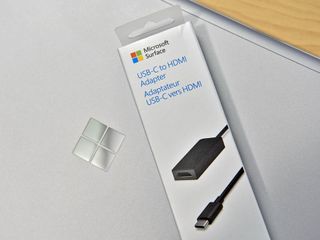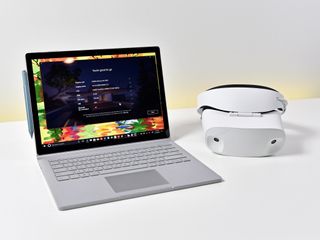Surface USB-C to HDMI adapter is pricey but works well for Windows Mixed Reality
The world is slowly shifting to an all USB Type-C world, and that port can handle everything from data to external displays. The Surface Book 2 finally got on board with this emerging technology dropping the DisplayPort from the previous generation.

One issue, however, is the new Surface Book 2 needs an HDMI adapter for the current generation of Windows Mixed Reality (WMR) headsets. Microsoft now has a solution on the market with the Surface USB-C to HDMI adapter. Selling for a massive $39.99, it is not cheap.

Starts at $39.99
Bottom line: The Surface Type-C adapter works very well for the Surface Book 2, including for Windows Mixed Reality, but the price is nearly double that of non-Microsoft branded adapters with similar specifications.Pros:
Supports HDMI 2.0.Active format adapter.Decent size and feature set.Cons:
Expensive.Not clear on all supported specifications.In the box and specifications

The Microsoft Surface USB-C to HDMI adapter is straightforward. On one end is the USB-C plug, the other a female HDMI adapter. The cord connecting the two ends is six inches (15.2 cm) in length, which is long enough for most scenarios including WMR.
Microsoft's dongle is HDMI 2.0 compatible and 4K-ready. More interestingly, the company notes that it is "an active-format adapter" that supports AMD Eyefinity and NVIDIA.
This reference to active format adapter is essential and one of the reasons why it may cost so much. Active format adapters make up for sources that do not support dual-mode DisplayPort (also known as DP++). The adapters have extra hardware on them to do the DP++ conversion, making them more robust and compatible regardless of the systems being connected. That also can drive up the price.
AMD Eyefinity and NVIDIA support ties into those company's own and often proprietary optimization for multi-display setup, which this adapter evidently allows.
Unfortunately, I have not been able to determine if the adapter supports the newer HDCP 2.2 security standard for 4K UHD streaming content. While all HDCP 2.2 adapters support HDMI 2.0, not all HDMI 2.0 parts support HDCP 2.2. I've reached out to Microsoft to ask about support and will update this review accordingly.
Update 1/4/18: Microsoft has now confirmed that the USB-C adapter does support HDCP 2.2.
Get the Windows Central Newsletter
All the latest news, reviews, and guides for Windows and Xbox diehards.
Finally, it should be evident that being HDMI 2.0 ipso facto means the forthcoming HDMI 2.1 modification is not here either. That revision won't start seeing consumer applications until sometime in 2018, though.
Windows Mixed Reality works beautifully

During my review of the Surface Book 2, I noted that support for WMR seemed like an afterthought for Microsoft.
The reason for the claim was port choice and placement. Would a full HDMI port have been warranted? Probably not, but it would have helped since WMR headsets exclusively use HDMI adapters for the current generation. I expect to see that shift over the next few years with USB-C connections instead.
Placement is problematic, too, since the secondary USB-A plug needed for power delivery to the WMR headset is on the opposite side of the USB-C port. That means the cable needs to split and have enough slack to hit both sides of the Surface Book 2, which is larger on the 15-inch model.
Additionally, I experienced a flickering issue when I ran WMR with the Surface Book 2 at first. At the time, all I had was an HP USB-C to HDMI converter, but Microsoft assured me that it was likely the converter not the laptop causing the problem.
Luckily, the Microsoft Surface USB-C to HDMI adapter had no such problems. I ran a Dell WMR headset, and the experience was fantastic. Scenes were crisp with no odd image pulsing. Combined with the power of the NVIDIA GTX 1060 video card on the Surface Book 2 15, the whole experience was outstanding.
While I still don't love the split-port setup, overall, running WMR on the Surface Book 2 with this adapter is great.
Converting to mixed reality isn't cheap
The Microsoft Surface USB-C to HDMI adapter connected to my 4K OLED LG TV just fine with sound. Running UHD YouTube videos or content from Microsoft Movies & TV went without a hitch, with excellent color reproduction and full audio. The same goes for external displays.
The big issue with the Microsoft Surface USB-C to HDMI adapter comes down to price. At $40, it is easily one of the most expensive adapters you can buy for this functionality. This pricing is not out of the ordinary for Microsoft, which charges the same $39.99 for all its Surface-branded adapters.


The good news is if you do plunk down your money, Microsoft guarantees this will work with the Surface Book 2 (of course, it should work with any PC that supports USB-C). But between it being tested for Surface Book 2 and it working well with Windows Mixed Reality, the price for peace of mind is worth it for some.
For half the price, Amazon sells a very well-reviewed adapter that also includes support for HDCP 2.2. I'll be reviewing that adapter with Surface Book 2, but it seems unlikely that it will have negatives compared to the Microsoft-branded version. Nonetheless, HDMI and adapters are tricky, so buyer beware.

Daniel Rubino is the Editor-in-chief of Windows Central. He is also the head reviewer, podcast co-host, and analyst. He has been covering Microsoft since 2007, when this site was called WMExperts (and later Windows Phone Central). His interests include Windows, laptops, next-gen computing, and watches. He has been reviewing laptops since 2015 and is particularly fond of 2-in-1 convertibles, ARM processors, new form factors, and thin-and-light PCs. Before all this tech stuff, he worked on a Ph.D. in linguistics, watched people sleep (for medical purposes!), and ran the projectors at movie theaters because it was fun.